Seating for Seven
The best values for 2007 put minivans out to pasture.

Minivans have lost the people-mover war. Despite having evolved to a nearly perfect design -- easy to enter and exit, comfortable for up to eight passengers and rife with cup holders -- GM, Ford and Mazda are abandoning their models entirely. Minivan sales last year slipped 11%, to less than one million. The victors? Crossover SUVs, whose sales rose 5%, to 2.4 million.
Crossovers mate practicality with cool -- and cool is something that minivans always lacked. They resemble traditional SUVs and provide the same tall-in-the-saddle view Americans love. But crossovers don't have the atrocious gas mileage and stiff, truck-like handling. That's because instead of body-on-frame construction, crossovers have a body and chassis built as a single unit.
In addition to car-like handling, they're also lower to the ground for less wind resistance (which improves fuel economy), easier to access and more resistant to rollover. Most aren't rugged enough to drive off-road, but they offer all-wheel drive to help negotiate snowy roads.

Sign up for Kiplinger’s Free E-Newsletters
Profit and prosper with the best of expert advice on investing, taxes, retirement, personal finance and more - straight to your e-mail.
Profit and prosper with the best of expert advice - straight to your e-mail.
If 2006 was the year of the crossover, 2007 promises to be the year of the big crossover. These models rob minivans of their last advantage -- third-row seats -- although unlike minivans, which are generally spacious, results were mixed for the crossovers' back benches. But as with minivans, crossovers' third- and second-row seats fold flat to let you haul stuff instead of people. (See our reviews for seven of the newest seven-passenger crossovers beginning on the next page.)
Among luxury models, the Acura MDX gets the top, five-star rating for overall value. It offers sport-sedan handling and a valet-impressing design for thousands less than its peers. Among non-luxury models, the GMC Acadia earns five stars for its mix of amenities plus the most passenger and cargo room. Also earning five stars is Mazda's CX-9, which combines sportiness and good handling with a thoughtfully designed, utilitarian interior.
Because there's a mix of luxury and non-luxury models, we've tried to compare apples to apples as much as possible by choosing base-trim-level luxury models and the upscale trims of the non-luxury models. When third-row seats aren't standard on the base model, we price the model in which they are. For example, Audi sells a V6-engine Q7 that starts at $40,000; but to get a third-row seat, you have to pay an extra $690. Likewise, a third row is a $1,700 option on the BMW X5, so we add that to the sticker price.
All the models have all-wheel drive, and all are fully equipped with standard safety features, including head-protection side-curtain airbags and stability control, which helps prevent skids. Most also have anti-rollover technology, which senses an impending tip-over and adjusts power to each wheel to prevent it. Side and rear visibility for most of these models is passable, but a rear-view camera is a smart option.
Reviews: How the seven-seaters compare
Sticker price is the manufacturer's suggested retail price, and invoice is more or less what the dealer pays. Aiming to pay the invoice price is a worthy goal, but because these new models are in demand, most consumers have been paying close to sticker.
Annual fuel cost is based on 15,000 miles of mixed city and highway driving, with regular gasoline at $2.40 a gallon and premium at $2.60. Vehicles for which premium is recommended are noted with a P. Resale value is an estimate of what a dealer would offer for the vehicle as a trade-in three and five years down the road. Figures come from Kelley Blue Book. Service cost is an estimate of the cost of maintenance and unscheduled repairs over five years. Figures come from Vincentric, an auto-research firm. Cargo room is the space behind the second-row seats when the third row is folded flat. Utility/comfort is a measure of cargo and passenger space and third-seat comfort.
Overall value is based on total five-year ownership costs as well as driving impressions. Utility/comfort and overall value are both rated on a scale of one to five.
Acura MDX

Utility/comfort:

Overall value:

Sticker price/invoice:
Annual fuel cost:
Resale value (3/5 yrs.):
Service cost (5 yrs.):
Cargo room:
If you're looking for sport-sedan handling, the redesigned MDX fits the bill. Acura's Super Handling all-wheel drive sends power to any of the four wheels as needed to help traction.
The 3.7-liter, 300-hp V6 is frisky, and the steering and suspension give fine feedback from the road. Handling is secure, and the MDX is fun to drive. But if you want maximum utility, look elsewhere. The MDX is shorter than most crossovers with third-row seats, so the third row is a little cramped for adults. Even so, the MDX maintains as much passenger volume (142 cubic feet) and cargo room as the much-larger Mercedes-Benz GL450.
You get a lot for your $40,000, especially compared with other luxury crossovers. Standard-equipment amenities include a moonroof, heated seats, tri-zone climate control, hands-free phone connection and XM satellite radio.
Audi Q7 3.6 Quattro
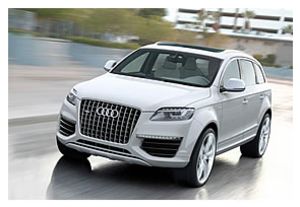
Utility/comfort:

Overall value:

Sticker price/invoice:
Annual fuel cost:
Resale value (3/5 yrs.):
Service cost (5 yrs.):
Cargo room:
The 3.6 Q7 is a 280-hp, V6-equipped luxe-mobile that accelerates quickly and smoothly. Beautifully crafted inside and out, it has features for rugged off-roading, too. But owning Audi's first SUV will cost you. Though the sticker price is about the same as for the Acura MDX, five-year ownership costs are $9,000 higher, according to Vincentric, mainly due to higher fuel, insurance and maintenance costs.
And you pay dearly for most options: $2,000 for heated leather seats and $1,850 for the sunroof (with three panels). A DVD player can be installed by dealers. Optional technical goodies -- including "side assist," which alerts you when a car is in your blind spot, and adaptive cruise control, which modifies your speed to match the traffic in front of you -- are nice, but they're available only on the Premium model, which costs an extra $6,000. (The Q7 also comes in a 4.2-liter, V8 version for an extra $10,000.)
Getting to the third-row seat is hassle-free. But adults of even average stature will bump their head on the rear-sloping roof.
BMW X5 3.0si
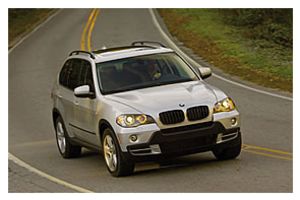
Utility/comfort:

Overall value:

Sticker price/invoice:
Annual fuel cost:
Resale value (3/5 yrs.):
Service cost (5 yrs.):
Cargo room:
The X5 is the vehicle Acura was clearly gunning for with its new MDX: Both vehicles tune steering and suspension to ride on the sporty side, and both are shorter than most other stretched crossovers. But the Bimmer, though bigger (and faster) than its predecessor, has far less passenger and cargo room than the competition.
The third-row seat, a $1,700 option, is tolerable for adults, but you have to tumble the heavy second-row seats forward for access. Cargo room behind the second-row seats is skimpiest of the group. Leather seating in the base model costs $1,450, and a moonroof costs $1,350.
Standard equipment includes rain-sensing windshield wipers and Xenon headlights. The $2,600 technology package has a rearview camera and voice-activated navigation system. Ownership costs aren't out of line if you don't go overboard with options.
GMC Acadia SLT AWD

Utility/comfort:

Overall value:

Sticker price/invoice:
Annual fuel cost:
Resale value (3/5 yrs.):
Service cost (5 yrs.):
Cargo room:
The Acadia's long wheelbase allows a third-row seat where up to three adults can ride in reasonable comfort. The second-row seats slide forward to allow easy entry.You can choose either two second-row captain's chairs (to seat seven total) or a second-row bench (to seat eight). A 3.6-liter V6 produces 275 hp but keeps fuel economy at 17 mpg city and 24 highway (slightly better for the two-wheel-drive model, which is $2,000 cheaper).
Standard equipment includes heated seats, heated outside mirrors and parking assist (a backup camera will be available this fall). One year's subscription to OnStar is free. The sunroof (including a second one for second-row passengers) costs $1,300.
The $2,145 navigation system is intuitive, but there's no hands-free connection for a cell phone. (Note: The Acadia shares a platform and powertrain with the Saturn Outlook and Buick Enclave.)
Mazda CX-9 Touring AWD
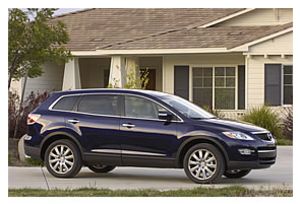
Utility/comfort:

Overall value:

Sticker price/invoice:
Annual fuel cost:
Resale value (3/5 yrs.):
Service cost (5 yrs.):
Cargo room:
Attention to detail -- such as second-row seats that slide forward for easy access to the third row as well as adjust back and forth and recline -- make Mazda's third crossover one of the best of the new breed. The driver's seat is comfortable and supportive. Driving dynamics are first-rate, too.
The 263-hp, 3.5-liter V6, combined with a six-speed transmission, is smooth and peppy and cornering is secure. The dashboard illumination is a soothing blue, and there's indirect lighting embedded in the front- and rear-door trim and the ceiling. Outside, the design picks up styling cues from Mazda's CX-7 small SUV.
All models include a third-row seat as standard equipment. The Touring model priced here is the mid-trim-level CX-9. Hands-free phone connection and heated seats are standard, but you'll pay at least $4,477 to get navigation, which is packaged with other options.
Mercedes-Benz GL450
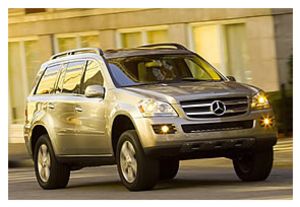
Utility/comfort:

Overall value:

Sticker price/invoice:
Annual fuel cost:
Resale value (3/5 yrs.):
Service cost (5 yrs.):
Cargo room:
For a big crossover, the GL450 handles well. And Mercedes ladles on extras, such as maple wood trim, "load leveling" air suspension that can raise the chassis 3 inches for off-roading, and a sunroof for third-row passengers. Third-row seats are comfy and easy to get into.
Of course, you pay for those amenities, and others: The main sunroof is a $1,500 option, as is leather seating. Three-zone climate control costs $1,320. You'll pay $1,450 for the audio upgrade package that includes hands-free communication, and navigation is available only as part of a $4,500 package. Ownership costs aren't cheap, either, after you pay for premium gas for the 4.6-liter, 335-hp V8 engine and high service costs. And I couldn't overcome the feeling that I was disconnected from the road and my surroundings -- mostly because visibility is lousy. The $500 rearview camera is a must.
Suzuki XL7 Luxury AWD
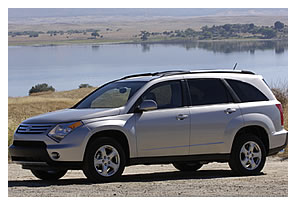
Utility/comfort:

Overall value:

Sticker price/invoice:
Annual fuel cost:
Resale value (3/5 yrs.):
Service cost (5 yrs.):
Cargo room:
The XL7 is half a foot narrower than most of the other crossovers in this group. That translates into stingy center-console storage space -- the cubby where the ashtray used to be was too small for my small cell phone -- and tighter quarters for passengers. The engine, at least in my preproduction test-drive vehicle, was noisy, and I struggled to get into the third row and to fold the second- and third-row seats flat.
On the other hand, handling is sure-footed, and a lot of amenities come standard: heated seats, steering-wheel audio controls, keyless entry with remote engine starter, roof rack and security system, to name a few. (A sunroof is an $800 option, and navigation is available only on the top trim level.) Resale value is the worst of the bunch. Models with front-wheel rather than all-wheel drive cost $1,600 less.
Get Kiplinger Today newsletter — free
Profit and prosper with the best of Kiplinger's advice on investing, taxes, retirement, personal finance and much more. Delivered daily. Enter your email in the box and click Sign Me Up.

Mark was the editor of Kiplinger's Personal Finance magazine from July 2017 to June 2023. Prior to becoming editor, he was the Money and Living sections editor and, before that, the automotive writer. He has also been editor of Kiplinger.com as well as the magazine's managing editor, assistant managing editor and chief copy editor. Mark has also served as president of the Washington Automotive Press Association. In 1990 he was nominated for a National Magazine Award. Mark earned a B.A. from University of Virginia and an M.A. in Writing from Johns Hopkins University. Mark lives in Washington, D.C., with his wife, and they spend as much time as possible in their Glen Arbor, Mich., vacation home.
-
 Financial Planning's Paradox: Balancing Riches and True Wealth
Financial Planning's Paradox: Balancing Riches and True WealthWhile enough money is important for financial security, it does not guarantee fulfillment. How can retirees and financial advisers keep their eye on the ball?
By Richard P. Himmer, PhD Published
-
 A Confident Retirement Starts With These Four Strategies
A Confident Retirement Starts With These Four StrategiesWork your way around income gaps, tax gaffes and Social Security insecurity with some thoughtful planning and analysis.
By Nick Bare, CFP® Published
-
 Roth IRA Contribution Limits for 2025
Roth IRA Contribution Limits for 2025Roth IRAs Roth IRA contribution limits have gone up. Here's what you need to know.
By Jackie Stewart Last updated
-
 Four Tips for Renting Out Your Home on Airbnb
Four Tips for Renting Out Your Home on Airbnbreal estate Here's what you should know before listing your home on Airbnb.
By Miriam Cross Published
-
 Five Ways to a Cheap Last-Minute Vacation
Five Ways to a Cheap Last-Minute VacationTravel It is possible to pull off a cheap last-minute vacation. Here are some tips to make it happen.
By Vaishali Varu Last updated
-
 How to Figure Out How Much Life Insurance You Need
How to Figure Out How Much Life Insurance You Needinsurance Instead of relying on rules of thumb, you’re better off taking a systematic approach to figuring your life insurance needs.
By Kimberly Lankford Last updated
-
 Amazon Big Deal Days Is Coming! We’ve Got All the Details
Amazon Big Deal Days Is Coming! We’ve Got All the DetailsAmazon Prime To kick off the holiday season with a bang, Amazon Big Deal Days runs Tuesday, October 8 and Wednesday, October 9.
By Bob Niedt Last updated
-
 How to Shop for Life Insurance in 3 Easy Steps
How to Shop for Life Insurance in 3 Easy Stepsinsurance Shopping for life insurance? You may be able to estimate how much you need online, but that's just the start of your search.
By Kaitlin Pitsker Last updated
-
 Five Ways to Shop for a Low Mortgage Rate
Five Ways to Shop for a Low Mortgage RateBecoming a Homeowner Mortgage rates are high this year, but you can still find an affordable loan with these tips.
By Daniel Bortz Last updated
-
 Retirees, It's Not Too Late to Buy Life Insurance
Retirees, It's Not Too Late to Buy Life Insurancelife insurance Improvements in underwriting have made it easier to qualify for life insurance, which can be a useful estate-planning tool.
By David Rodeck Published